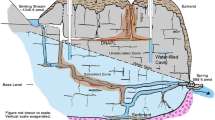Abstract
Groundwater samples taken from wells adjacent to a food machinery manufacturing plant in southern Taiwan indicate that there is a serious phenolic contamination. To understand the hydrogeological properties, and to prepare for remedial action, a series of hydrogeological investigations were conducted. Investigative work included collecting background information, analyzing existing data, measuring the groundwater, and conducting a slug test, pumping and recovery test, aerial photography analysis and electrical resistivity survey. Results from these investigations show that the local groundwater aquifer may be classified as an unconfined or confined formation, depending on the thickness of the interbedded clay layer. The direction of local groundwater flow is from southwest to northeast, with high transmissivity. The contaminant moves much more slowly than the average groundwater velocity, and it is limited to an area centered around the plant. The local geology of the contaminated area exhibits significant heterogeneity; it is not likely to have been formed by natural sedimentation. Data from the field aerial photography analysis and electrical resistivity survey also suggest that this shallow formation may result from artificial back-filling.
Similar content being viewed by others
Author information
Authors and Affiliations
Additional information
Received: 1 September 1994 · Accepted: 28 December 1995
Rights and permissions
About this article
Cite this article
Liu, C., Cheng, L. Hydrogeological investigation of a groundwater contamination site in southern Taiwan. Environmental Geology 29, 238–245 (1997). https://doi.org/10.1007/s002540050122
Issue Date:
DOI: https://doi.org/10.1007/s002540050122




